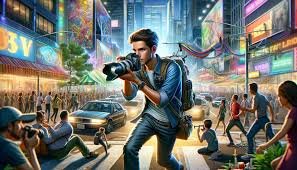
Introduction to News Reporter 7.5
The concept of News Reporter 7.5 represents a significant evolution in modern journalism, reflecting the transformative effects of technology and social media on the news industry. Traditionally, news reporting was firmly rooted in established practices that emphasized formal journalistic standards and conventions. However, the rise of digital platforms has not only democratized content creation but has also introduced new players into the reporting landscape.
Among these emerging figures is the so-called “frat boy photographer,” a term that captures a youthful, often informal approach to news reporting. This new breed of journalist utilizes photography and social media to engage with their audience in ways that were once considered unconventional. The blending of traditional reporting techniques with innovative and relatable content strategies enables these modern reporters to attract younger demographics who may be disengaged from conventional news outlets.
The role of News Reporter 7.5 transcends the simplistic notion of merely gathering facts. It encapsulates the act of storytelling, where images and narratives are crafted to resonate with a digital audience. By leveraging platforms like Instagram, TikTok, and Twitter, these reporters create immersive experiences that invite audience participation and feedback, fostering a two-way dialogue that was rarely possible in the past.
This shift in journalism not only enhances accessibility but also encourages transparency and authenticity, elements that are crucial for younger consumers of news. As the landscape of journalism continues to shift, understanding the dynamics at play between traditional and contemporary forms of reporting will be vital for those seeking to navigate this new terrain. As we delve deeper into the implications of News Reporter 7.5, it becomes clear that these changes are not mere trends; they represent fundamental shifts in how news is shared, consumed, and perceived.
Profile of the Frat Boy Photographer
The ‘frat boy photographer’ is a complex character who embodies the intersection of youthful exuberance and journalistic ambition. Growing up in a vibrant university environment, he joined a fraternity that significantly influenced his worldview and approach to storytelling. His tenure in this social organization not only provided him with lifelong friendships but also instilled a sense of camaraderie and teamwork that resonates in his journalistic pursuits. The interactions and experiences garnered during fraternity events shaped his understanding of people and situations, allowing him to create compelling narratives through his lens.
Motivated by a desire to capture the essence of life as he sees it, the frat boy photographer leverages his background in both photography and journalism. He believes every image should tell a story, a belief further enhanced by the lessons learned through group activities and collaborative projects within his fraternity. His approach to journalism extends beyond traditional methods; instead, he strives to incorporate a sense of fun and creativity that is often found in campus life. His youthful outlook allows him to connect with a generation that craves authenticity and relatability in media.
While his vibrant style has its strengths, it is not without shortcomings. Critics may argue that his lighthearted approach could undermine the gravitas of serious news narratives. However, the frat boy photographer aims to strike a balance, showcasing the importance of context and depth in storytelling. Personal experiences, particularly light-hearted or humorous anecdotes from his time as a fraternity member, serve to enrich his narrative voice, offering a unique perspective that stands out in the crowded field of journalism. The frat boy photographer is an embodiment of the modern reporter—a blend of passion, creativity, and a profound understanding of the human experience.
The Impact of Youthful Perspectives in Journalism
The emergence of youthful perspectives in journalism, exemplified by figures such as the news reporter 7.5: the frat boy photographer, has introduced a distinct approach to storytelling that challenges the conventional paradigms established in the media. Unconventional journalists often bring unique narratives that resonate deeply with younger demographics. Their fresh viewpoints can forge connections with an audience that traditional media may overlook. The college experience, popular culture, and the evolving social landscape serve as a rich tapestry for these new voices, portraying stories that are often ignored by mainstream reporters.

Moreover, the frat boy photographer exemplifies how non-traditional journalists can highlight issues pertinent to younger generations. Their willingness to engage with topics like social justice, mental health, and the complexities of modern relationships fosters a platform for dialogue that speaks directly to their peers. In doing so, they not only enhance visibility for these issues but also influence public perception, drawing attention to narratives that embody authenticity and relatability. This representation in journalism holds significance; it allows diverse realities to be portrayed, thereby enriching the media landscape.
However, the rise of these youthful voices is not without criticism. Detractors may argue that an avant-garde style could compromise journalistic integrity, raising concerns about sensationalism or a lack of professionalism. While it is critical to uphold the core values of journalism—accuracy, fairness, and impartiality—there is also a pressing need for a balance. Integrating innovative storytelling with traditional reporting methods can lead to a richer media experience, enhancing the overall quality of journalism. The contributions of young reporters, like news reporter 7.5: the frat boy photographer, ultimately highlight the importance of diverse viewpoints while reminding us of the responsibility inherent in storytelling. In conclusion, it is vital to embrace these new narratives that can invigorate journalistic practice while maintaining a commitment to ethical reporting standards.
Conclusion and Future of News Reporting
The realm of journalism is continually evolving, shaped by technological advancements and a growing demand for diverse perspectives. As we reflect on the themes surrounding the news reporter 7.5: the frat boy photographer, it becomes evident that unconventional voices play a significant role in enriching the storytelling landscape. This unique blend of traditional journalism principles infused with fresh, contemporary approaches leads to more engaging and varied narratives. The incorporation of such figures not only broadens the spectrum of representation but also allows for the exploration of stories that resonate more profoundly with younger audiences.
Looking ahead, several trends may emerge within the field of news reporting. First, we can expect an increasing emphasis on multimedia storytelling, where visual content, such as photography and video, becomes paramount. The aptitude of the frat boy photographer exemplifies how caliber in visual representation can enhance journalistic endeavors. This could pave the way for more innovative reporting formats that leverage technology and social media platforms to reach a wider audience effectively.
Moreover, the demand for authenticity and relatability in news reporting could lead to more journalism initiatives that highlight grassroots stories and lived experiences. News reporters will likely need to cultivate a more personal connection with their audience, ensuring that reporting remains relevant in a rapidly changing digital ecosystem. Therefore, the roles figures like the frat boy photographer could adopt may expand to encompass community engagement and narrative creation that is both compelling and informative.
As consumers of news, it is imperative to approach media critically, recognizing the power of diverse voices and new methodologies in shaping our understanding of contemporary issues. The future of news reporting rests not only on the shoulders of journalists but also on the awareness and engagement of its audience.



